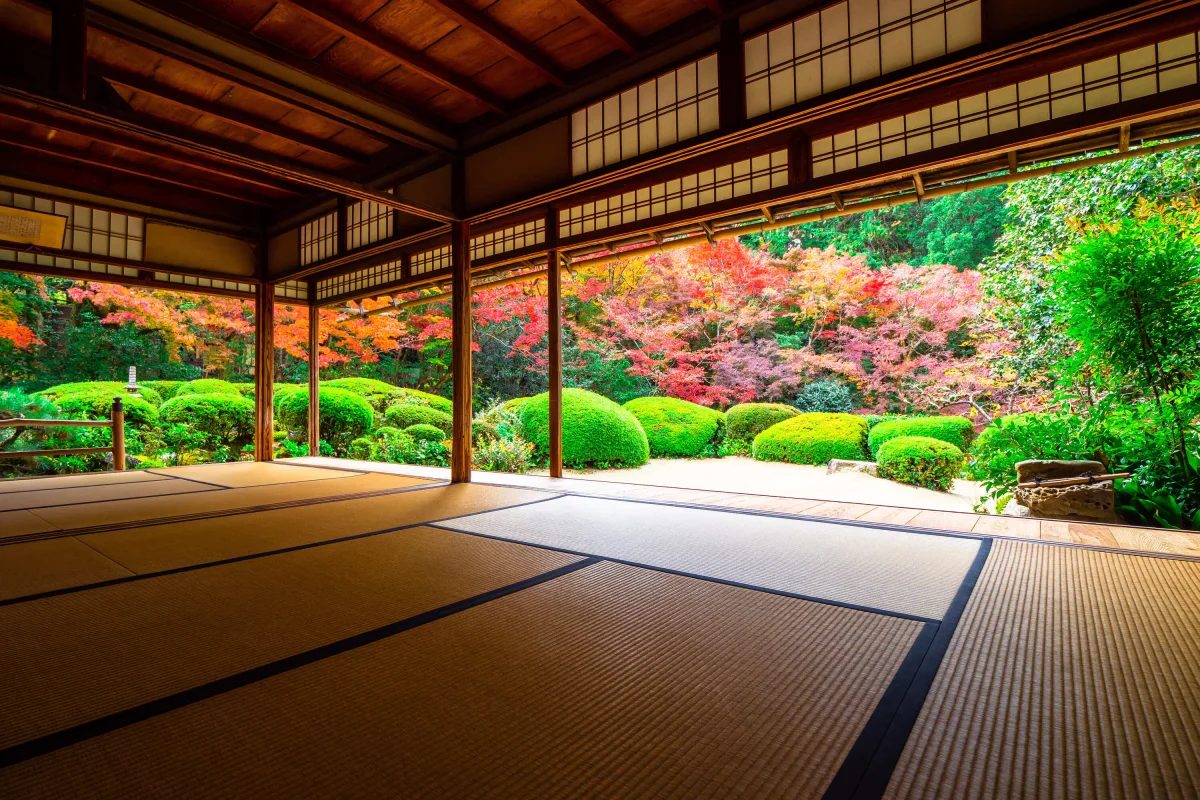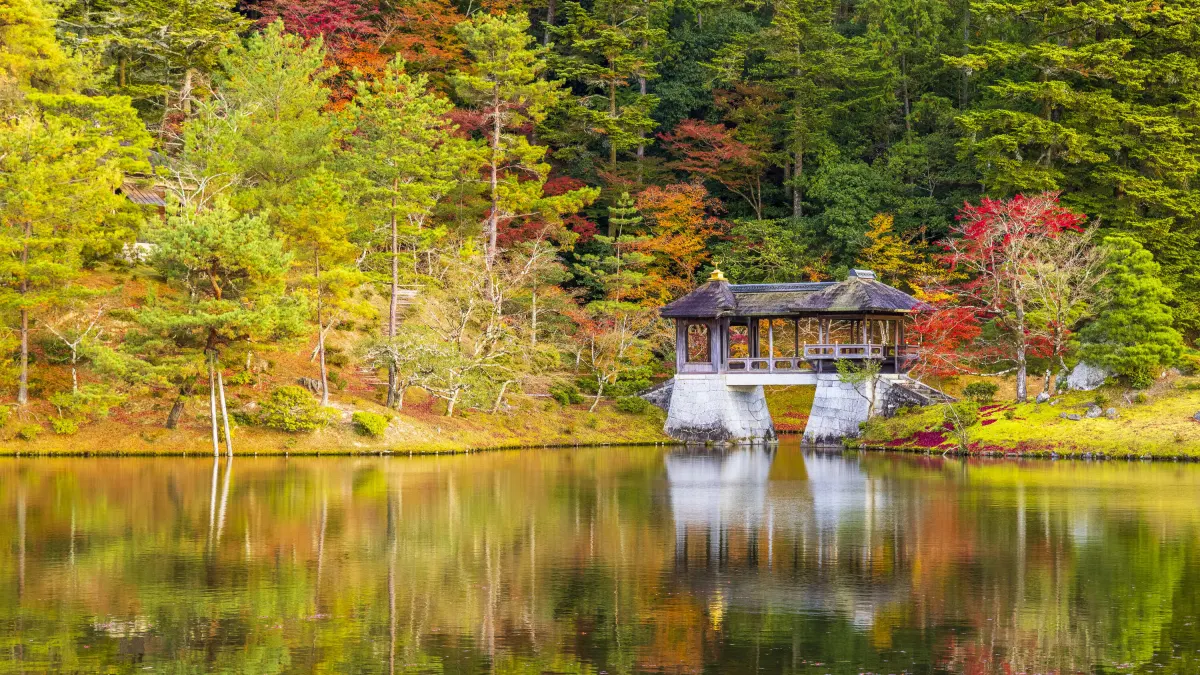Saiho-ji [西芳寺], known as the Moss Temple or Kokedera Temple, is a celebrated strolling garden built around a mirror-like central pond. More than 120 moss varieties blanket the grounds, creating a lush, velvety landscape that shifts in tone with the seasons, bright emerald in summer, softly muted in winter, and richly contrasted by autumn leaves. Winding paths, stone bridges, and carefully placed pines frame ever-changing views, while reflections of sky and trees ripple across the water. Limited entry and advance reservations preserve the garden’s tranquility, allowing visitors to immerse themselves fully in its quiet, timeless beauty.
Kyoto is home to some of Japan’s most celebrated gardens, each shaped by centuries of tradition, aesthetic principles, and a deep reverence for nature. From the meticulous dry landscapes of Zen temples to lush strolling gardens designed for imperial retreats, these spaces are living works of art that change character with the seasons. Walking through them offers more than just scenic beauty, it’s a journey into Kyoto’s cultural soul, where architecture, water, stone, and plant life are composed with deliberate harmony.
Comprehensive rating for Kokedera Moss Temple
Our lens score combines visitor ratings, review volume, photo evidence, and expert assessments across 8 key categories.
Ryoan-ji [龍安寺] is renowned for its karesansui [枯山水] rock garden, a refined expression of Zen simplicity. Fifteen stones rest in raked white gravel, yet only fourteen can be seen from any angle, inviting reflection on imperfection and the search for completeness. Beyond this minimalist masterpiece lies Kyoyochi Pond, a tranquil expanse framed by maples, pines, and seasonal blooms. In summer, lotus flowers drift across the water; in autumn, fiery foliage reflects on its surface. Winding paths, mossy banks, and traditional structures create a harmonious blend of textures and views, offering a peaceful counterpoint to the rock garden’s austerity.
Comprehensive rating for Ryoan-ji Temple
Our lens score combines visitor ratings, review volume, photo evidence, and expert assessments across 8 key categories.
Shisendō [詩仙堂] is a hillside retreat where garden design, seasonal beauty, and quiet contemplation merge. Its compact yet artfully layered grounds feature a white sand court bordered by precisely trimmed azaleas, opening into a backdrop of maples and evergreens. A famed shishi-odoshi [鹿威し] adds a gentle, rhythmic sound, enhancing the garden’s meditative atmosphere. In spring, azaleas bloom in soft pinks and whites; summer brings lush greenery; autumn ignites the scene with crimson foliage. The garden’s use of natural slope creates shifting perspectives from the temple’s verandas, embodying the wabi-sabi aesthetic and offering a tranquil escape from Kyoto’s busier sights.
Comprehensive rating for Shisendo Temple
Our lens score combines visitor ratings, review volume, photo evidence, and expert assessments across 8 key categories.
Murin-an [無鄰菴] is a Meiji-era garden by master designer Ogawa Jihei VII, celebrated for its innovative use of Higashiyama as borrowed scenery. Streams fed by the Lake Biwa Canal weave through lawns, unusual for traditional Japanese gardens, while gentle waterfalls create a soothing soundscape. Carefully placed stones, trees, and open grass areas frame shifting views that feel both natural and artfully composed. The blend of water, greenery, and distant mountain backdrop offers a serene yet dynamic atmosphere, inviting slow exploration from winding paths or the villa’s verandas.
Comprehensive rating for Murin-an Garden
Our lens score combines visitor ratings, review volume, photo evidence, and expert assessments across 8 key categories.
Shoseien Garden [渉成園], also known as Kikoku-tei [枳殻邸], is a 3.3-hectare strolling garden that pairs Edo-period elegance with a deep sense of tranquility despite its location near Kyoto Station. Centered on Ingetsuchi [印月池], a crescent-shaped pond mirroring seasonal skies and foliage, the landscape unfolds through meandering paths, arched bridges, and teahouses shaded by maples and pines. Artificial hills, stepping stones, and carefully framed views invite unhurried exploration in every season, cherry blossoms and fresh greenery in spring, lotus flowers in summer, fiery foliage in autumn, and clear, reflective waters in winter. Elements from Kyoto Imperial Palace, Jurakudai, and Fushimi Castle are woven into its structures and stonework, adding layers of history to its natural beauty.
Comprehensive rating for Shoseien Garden
Our lens score combines visitor ratings, review volume, photo evidence, and expert assessments across 8 key categories.
Nanzen-ji [南禅寺] pairs monumental architecture with gardens that embody Zen refinement. The Hojo’s karesansui [枯山水] garden, designed by Kobori Enshu, arranges raked white gravel, moss islands, and sculpted pines into a composition that feels both minimal and profound. Seasonal changes frame the scene, fresh greens in spring, fiery maples in autumn, while quiet sub-temple gardens offer more intimate views. The grounds also feature natural elements like shaded paths and water channels, complemented by the striking Suirokaku Aqueduct, where flowing water meets temple serenity. Together, these spaces invite both visual contemplation and a deep sense of stillness.
Comprehensive rating for Nanzen-ji Temple
Our lens score combines visitor ratings, review volume, photo evidence, and expert assessments across 8 key categories.
Heian Jingu Shrine Garden [平安神宮神苑], designed by Ogawa Jihei VII, is a 33,000 m² masterpiece divided into four seasonal landscapes—South, West, Central, and East. At its heart lies Soryu-chi Pond, fed by the Lake Biwa Canal and crossed by elegant bridges, including the famed Garyo-kyo [臥龍橋], a series of massive stepping stones resembling a resting dragon. Plantings are choreographed for year-round beauty: spring’s weeping cherry blossoms, early summer irises and lotus blooms, fiery autumn maples, and the serene stillness of snow in winter. Stone lanterns, tea huts, and water features are precisely placed to merge natural flow with traditional garden design, while wildlife from kingfishers to turtles brings quiet vitality to the scene.
Comprehensive rating for Heian Shrine Garden East
Our lens score combines visitor ratings, review volume, photo evidence, and expert assessments across 8 key categories.
Shugakuin Imperial Villa
修学院離宮
Location PageGentle hillside gardens with sweeping Kyoto views
Location PageShugakuin Imperial Villa [修学院離宮] is a vast 17th-century garden estate renowned for its masterful use of shakkei [借景], or borrowed scenery, incorporating the Higashiyama mountains and Kyoto’s skyline into its design. Divided into Lower, Middle, and Upper Villas, each area blends natural terrain with artfully arranged ponds, streams, and seasonal plantings. The Upper Villa’s Yokuryu Pond offers one of Kyoto’s most celebrated panoramic views, framed by pavilions and tea houses that exemplify refined imperial architecture. Walking paths wind through open fields, groves, and water features, creating a sequence of landscapes that shift with the seasons, from fresh spring greens to vivid autumn foliage. Visitors must join guided tours lasting approximately 80-90 minutes, covering roughly 3 kilometers of walking paths.
Comprehensive rating for Shugakuin Imperial Villa
Our lens score combines visitor ratings, review volume, photo evidence, and expert assessments across 8 key categories.
Katsura Imperial Villa [桂離宮] is a pinnacle of strolling garden design, where winding paths lead through a sequence of meticulously composed views around a central pond. Irregularly shaped and edged with small islands, stepping stones, and ornamental rocks, the pond serves as the heart of the landscape, reflecting seasonal skies and surrounding pavilions. Tea houses in sukiya-style architecture are positioned to capture changing vistas, blending rustic elegance with refined detail. Stone lanterns, water basins, bamboo fences, and varied pathways create subtle shifts in texture and mood, guiding visitors through spaces that balance human artistry with the rhythms of nature. Advance reservation needed, tours run roughly 60 minutes, with 35 visitors per session.
Comprehensive rating for Katsura Imperial Villa
Our lens score combines visitor ratings, review volume, photo evidence, and expert assessments across 8 key categories.
Manshuin Temple [曼殊院門跡], often likened to a “Little Katsura Imperial Villa,” features a refined karesansui [枯山水] garden that reflects its imperial heritage. The composition centers on the famed Kame-no-iwa [亀の岩] (Turtle Rock), set in raked white gravel and framed by elegantly pruned pines. The garden’s simplicity emphasizes form, texture, and seasonal light, offering a quiet space for contemplation. Subtle changes in perspective reveal layered views, while the careful balance of stone and greenery captures the restrained elegance of Edo-period design. Its secluded location enhances the sense of serenity, making it a peaceful counterpart to Kyoto’s grander gardens.
Comprehensive rating for Manshuin Temple
Our lens score combines visitor ratings, review volume, photo evidence, and expert assessments across 8 key categories.
Whether blanketed in spring blossoms, glowing with autumn leaves, or resting quietly under winter’s light, Kyoto’s gardens invite slow exploration and mindful appreciation. Each visit reveals new details, from the way a pond reflects the sky to the sound of leaves rustling in the wind. Taking time to wander these spaces is not only a way to witness Kyoto’s beauty, but also to connect with its enduring spirit of harmony between humanity and nature.










